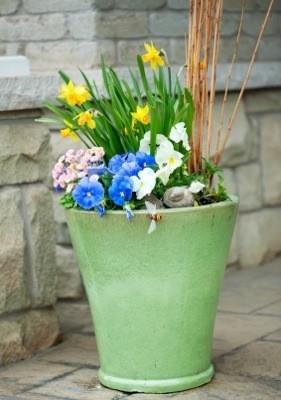Planning ahead for the seasons can add challenges to spring planting. Instead of planting each season, plant now to create an entire yearly display for much less than you'll pay to replant it each season. Why pay money to purchase plants and then throw them away?
Brighten your entryway by adding a planter to welcome visitors and draw attention to your front door. The look of your home's front door is an important element in your landscaping. Pulling out the season's flowers and replacing them is not only time consuming but expensive.
Think about the year ahead instead. We consider an entire season's planting when digging flower beds in the yard, but we often ignore them in potted displays. While pansies and winter cabbage are attractive, save them for your yard and keep them out of the potted plants. Instead, think about plants that will die down and reappear each year. Yearly plantings should be reserved for the larger planters.
For spring, plant some tall bulbs in your planter at a depth of six inches. This will allow the other plants to sit on top of the bulbs so the transition from spring to summer will be a seamless one. To protect your bulbs from squirrels, place a small cut piece of mesh wire on top of the bulbs before adding the remaining soil.
In summer, choose some perennial plants that can grow beneath the spring bulbs and continue to flower throughout the season. Opt for plants such as snapdragons. Then, to layer your look, add some taller greens in the back. This is great place to place herbs such as chives that not only bloom but also offer interesting greenery and useful seasoning.
When autumn arrives, the addition of chrysanthemums is too pricey and short lived. Instead, plant marigold seeds beneath your summer plants halfway through the season. The marigolds will grow amongst the summer flowers, adding to their beauty at the end of the summer. Their bright fall colors will brighten your planters, and they will withstand cooler temperatures before frost comes. Collect the dead flower heads and store them in a dry place for next year's planting.
As the frost line approaches your home, consider covering the planter with an old bed sheet at night. This will keep your flowers blooming and healthy longer. When the cold comes on strong, if you live in a colder climate, you'll have to add to your planter manually. Prune some interestingly shaped branches from around your yard and add them to the planter. If they have colored leaves, this will add to the display until the leaves dry. Bare sticks will continue the autumn look while adapting to the harsher temperatures.
For those who live in planting zone 6 and further north, this time period of autumn into winter is tricky for planters. Explore your recycling options. Continue to add the bare sticks as well as any dried berries and fall items you might find in your yard. Then, recycle the jack-o-lantern by turning his face to the back, covering it with the sticks and findings, and using the orange color to accentuate your display.
As winter approaches, create displays that look nice with and without snow. Keep the bare sticks and the recycled pumpkin in the display until the pumpkin freezes. Then, add pine branches cut from your trees or a neighbor's tree. As branches fall during ice storms, build on your planter's look.
With a little investment, purchase a small evergreen for the center of your pot. Keep the other flowers growing around it, and decorate it according to the season. The evergreen will look lovely with smaller spring bulbs around its base, small summer flowers such as sweet alyssum around its base, sticks and marigolds in autumn, and mulch in the winter.
It's important to mulch your planter during the winter. Keeping it close to the house or under a porch will help to protect it. Adding pine needles as mulch is also a cheap and decorative solution.

Add your voice! Click below to comment. ThriftyFun is powered by your wisdom!
Terrific article which has given me many ideas. Like especially the one about adding branches from the garden and the country. Alyssum self-seeds here ( in Northern Ireland! ) so that's another item to add; marigold seeds I have, so it's just the perennials and bulbs and perhaps a tiny conifer to find. Should you take it apart and replant it every season? Because it will make heavy demands on the soil's nutrients.
This article is fantastic. How about some choices for the warm climates like Florida. Anyone have some ideas? I'm fortunate that I do have some spots that are mostly shady with just a few hours of intense sun.
Add your voice! Click below to comment. ThriftyFun is powered by your wisdom!